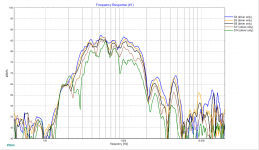To rule out cabinet effects, try to measure on-axis and watch that peak when you move the mic closer/further as well as higher/lower. See if it stays put or shifts around. I don't know why the peak should drop like that due to anything in the ports -- directivity effects near that frequency should be happening from more near to the end of the waveguide mouth.
Dunno, maybe. Horn Response (not sure I have the same model from then) shows if the port is too small/too short/too close to the throat that can give a peak about there. Maybe try some modeling clay to "lengthen" the ports and see what happens?
Doubt an off-axis null could be there, though. It could only happen from the distance of the ports from each other (tweeter isn't playing!), you'd have to get about 5 inches closer to one than the other from being off-axis for that to happen.
Doubt an off-axis null could be there, though. It could only happen from the distance of the ports from each other (tweeter isn't playing!), you'd have to get about 5 inches closer to one than the other from being off-axis for that to happen.
Yeah, looks like something off there. Here are some horizontal curves I have from a few years back (done indoors, unsmoothed, angles are 0, 20, 30, 45, 60).
View attachment 682485
What happens if you move the mic closer/further? (thinking cabinet edge diffraction maybe).
Do you have any absorption in back of the cone? I had a dip like that in my first Synergy proto and it turned out to be a reflection from the panel in back of the driver coming back through the cone and nulling at the mid port hole. Does the null freq correlate with the distance?
i'm not sure how to verify that definitively but it certainly seems a very firm/tight/complete seal3ll3d00d - are you sure the midrange driver is sealed against its mounting surface? Maybe an air leak could do that (guessing)
I took some more measurements, different location as I had to do it inside but with the mic on axis and then moving both left and right & up and down (to an extent of about +/- 1m). No obvious difference in that hump.
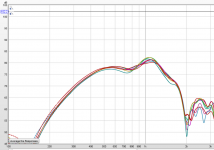
so then I took some quick and dirty off axis measurements at ~40 and 60 degrees both left and right
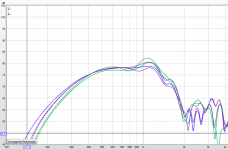
it was a bit rough and ready but still no sign of a dip, just a softening of the hump.
I finally got one one up and running
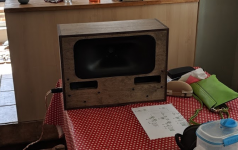
quick on axis FR in my kitchen to check it was wired up ok
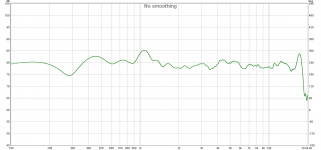
and the xo I have atm (which was tweaked a bit from the original design as my measurements showed a slightly different response shape with that XO, particularly on the CD), sims maintain v similar directivity pattern to the original though which I figured was the thing to aim for.
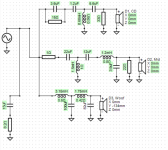
I will be running this with DSP so decided to leave that peak for DSP to fix
need to get it outside to measure it properly but will need to leave that for later in the week

quick on axis FR in my kitchen to check it was wired up ok

and the xo I have atm (which was tweaked a bit from the original design as my measurements showed a slightly different response shape with that XO, particularly on the CD), sims maintain v similar directivity pattern to the original though which I figured was the thing to aim for.

I will be running this with DSP so decided to leave that peak for DSP to fix
need to get it outside to measure it properly but will need to leave that for later in the week
Sure, but the directivity won't be uniform below about 900Hz anymore. The woofer array trick depends on the woofers being spaced properly, which is why they are partly behind the waveguide and feeding through close-in slots.
Hello Bill.
I really appreciated your work and provided details for this project.
Your Small Syns are small, dynamics and have unbelievable stage. The 3D is the best that you can wish for. The speakers are simply not exist - sound come from exact location of musicians and it's clear and precise. So they close the Ultimate Home Theater questions for me.
For my audio system I got Synergy horn 65sm wide by 30sm height with two JBL drivers. It works down to 300hz. What is the distance between two centers of 10" woofers (B&C 10CL51) to keep uniform directivity below 300Hz if I located them right bellow the horn as you did in original project for 6.5" Faitals?
Thank you,
Last edited:
For my audio system I got Synergy horn 65sm wide by 30sm height with two JBL drivers. It works down to 300hz. What is the distance between two centers of 10" woofers (B&C 10CL51) to keep uniform directivity below 300Hz if I located them right bellow the horn as you did in original project for 6.5" Faitals?
Thank you,
The array trick with the woofers only extends the directivity for about another half octave. If your horn currently holds directivity to 300Hz (seems like it would need to be wider than 65cm to do that, though - a 90 degree conical horn of 65cm should hold down to about 360Hz, to not as low for a narrower horn -- Keele's formula), you'd need the centers of the woofer slots to be about 85cm apart, assuming your angle is 90 degrees. For 360Hz and 90degrees, that would be about 71cm. Those are just estimates, of course, but are scaled to what worked for me on the SmallSyns.
Vertically, you want the slots to be just below (or just above) the horn to get their vertical centers as close as possible to the horn throat, which means the woofers have to be somewhat behind the horn.
Hope that helps.
Hello Bill.
I really appreciated your work and provided details for this project.
Your Small Syns are small, dynamics and have unbelievable stage. The 3D is the best that you can wish for. The speakers are simply not exist - sound come from exact location of musicians and it's clear and precise. So they close the Ultimate Home Theater questions for me.
For my audio system I got Synergy horn 65sm wide by 30sm height with two JBL drivers. It works down to 300hz. What is the distance between two centers of 10" woofers (B&C 10CL51) to keep uniform directivity below 300Hz if I located them right bellow the horn as you did in original project for 6.5" Faitals?
Thank you,
I love seeing these positive reviews. The speakers are really special. It feels so bizarre to go to CES, and find that 80-90% of the speakers for sale are inferior to something that costs a fraction as much.
IMHO, if you want to exceed these speakers, you have to start considering speakers that cost nearly six figures, like the Beolab 90.
Now if someone would just make a kit...
Hmm... Food for thought.The array trick with the woofers only extends the directivity for about another half octave. If your horn currently holds directivity to 300Hz (seems like it would need to be wider than 65cm to do that, though - a 90 degree conical horn of 65cm should hold down to about 360Hz, to not as low for a narrower horn -- Keele's formula), you'd need the centers of the woofer slots to be about 85cm apart, assuming your angle is 90 degrees. For 360Hz and 90degrees, that would be about 71cm. Those are just estimates, of course, but are scaled to what worked for me on the SmallSyns.
Vertically, you want the slots to be just below (or just above) the horn to get their vertical centers as close as possible to the horn throat, which means the woofers have to be somewhat behind the horn.
Hope that helps.
Thank's again.
I love seeing these positive reviews. The speakers are really special. It feels so bizarre to go to CES, and find that 80-90% of the speakers for sale are inferior to something that costs a fraction as much.
IMHO, if you want to exceed these speakers, you have to start considering speakers that cost nearly six figures, like the Beolab 90.
Hello Patrick.
When I first time heard Biolab 90 it's shocked me by the huge stage, synergy, beautiful tone and soft bass. But. Small Syns have better dynamics/attack, way smaller and 100 times (roughly) cheaper. If we are talking about ultimate sound, then Biolab 90 far from JBL 2169h mid and JBL 2384 horn with the 2435HPL driver (beryllium). The details, air and resolution of the JBL's is unbelievable. This couple sound as one wide range driver, the synergy is excellent even if you place the mid without of cabinet just bellow 2384 horn with the 2435HPL driver. Realism and dynamics is out of this world. I also tested that mid with high efficiency, extremely detail ribbon. Very good, but you can hear two sources and realism vent one step bellow. So you don't need six figures to build the ultimate speaker. But yes, it's still very, very expensive - you need nice processor, at least 3 amplifiers and wide range high efficiency bass solution (better midbass and sub) which are not cheep at all.
Last edited:
- Home
- Loudspeakers
- Multi-Way
- Small Syns
